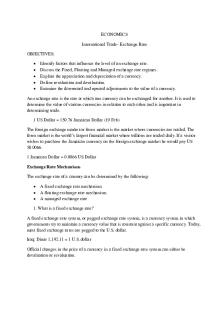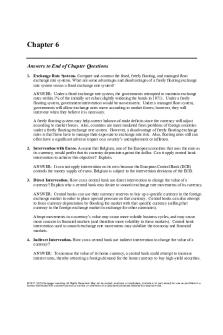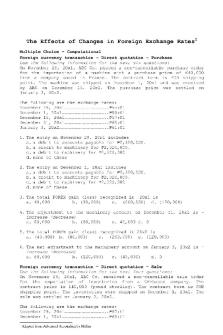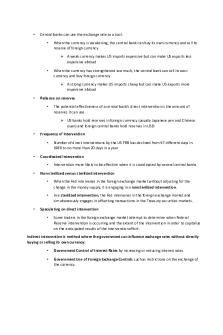10 Exchange Rates and Exchange Rate Systems PDF

| Title | 10 Exchange Rates and Exchange Rate Systems |
|---|---|
| Author | Xinyi Wang |
| Course | Intro To Global Trade & Fin |
| Institution | Emory University |
| Pages | 6 |
| File Size | 313.8 KB |
| File Type | |
| Total Downloads | 78 |
| Total Views | 169 |
Summary
Download 10 Exchange Rates and Exchange Rate Systems PDF
Description
10.1 Introduction: Fixed, Flexible, or In-Between? Every country must choose an exchange rate system to determine how prices in the home country currency are converted into prices in another country’s currency. The choice of an exchange rate system varies along the continuum from completely fixed with no variation to completely flexible with variation determined by supply and demand on a minute-by-minute basis. 10.2 Exchange Rates and Currency Trading The e xchange rate is the price of one currency stated in terms of a second currency. An exchange rate can be given in one of two ways, either as units of domestic currency per unit of foreign currency. We might give the U.S.–Mexico exchange rate as dollars per peso (0.05 dollars) or pesos per dollar (17.5 pesos). The U.S. dollar–British pound exchange rate is usually quoted in terms of dollars per pound, bu the U.S. dollar–Mexican peso exchange rate is usually pesos per dollar. Three of the most frequently traded currencies: the European Union’s euro, the Japanese yen, and the British pound. The rates are from the U.S. Fed’s website, and are the interbank rates that one bank charges another when buying large amounts of currency. All three are flexible exchange rates and subject to constant fluctuations up and down in value. In the years leading up to the financial crisis and recession of 2007–2009, the pound and the euro appreciated against the dollar. When the crisis began in late 2007, world demand for dollars rose and it appreciated in value, or to say the same thing another way, the pound and euro depreciated. The most dramatic depreciation began in mid-2008 and lasted for approximately a year, until mid-2009, reflecting the flight of capital into dollars The pound lost approximately 25% of its value in dollar terms and the euro lost approximately 15%. In contrast, the Japanese yen continued to appreciate until late 2012, gaining over 40% in value against the dollar, and then quickly reversed and lost all of its appreciated value by the middle of 2013. Considering that the changes in the real economies of each country were not nearly as large. By March, 2016, the yen was worth $0.0088, or less than 1 cent. The euro stood at $1.10 and the pound was worth $1.42. It might be tempting to conclude that the yen is weak and the pound and euro are strong given that the yen is not worth 1 cent and the other two ar well over 1 dollar. This would be a mistake, however, because currencies are scales, just like Fahrenheit and centigrade, or miles and kilometers. Until it began to lose some of its value in 2013, the yen appreciated against all three and was clearly the strongest. The strength or weakness of a currency is related to the direction of change in its value and not its value at one point in time. Reasons for Holding Foreign Currencies 1) trade and investment purposes. Traders (importers and exporters) and investors routinely transact in foreign currencies, either receiving or making payments in another country’s money. Tourists are included in this category because they hold foreign exchange in order to buy foreign goods and services. 2) to take advantage of interest rate differentials, or i nterest rate arbitrage. Arbitrage: the idea of buying something where it is relatively cheap and selling it where it is relatively expensive. Interest rate arbitrage is similar in that arbitrageurs borrow money where interest rates are relatively low and lend it where rates are relatively high. By moving financial capital in this way, interest rate arbitrage keeps interest rates from diverging too far, and also constitutes one of the primary linkages between national economies. Over the last several years interest arbitrageurs have played a major role in keeping the Japanese yen strong by borrowing in Japan where interest rates are very low and lending where they are high. Various other factors, such as perceptions of risk, are important. 3) to speculate. Speculators are businesses that buy or sell a currency because they expect its price to rise or fall. They have no need for foreign exchange to buy goods or services or financial assets; rather, they hope to realize profits or avoid losses through correctly anticipating changes in a currency’s market value. Speculators are often reviled in the popular press, but in fact they help to bring currencies into equilibrium after they have become over- or undervalued. If speculators view a currency is overvalued, they will sell it and drive down its value. If they guess wrong, they can lose a lot of money. However, some economists think that speculation against a currency can be destabilizing in the sense that it does not always push an exchange rate to its equilibrium value, but instead sometimes leads to a grossly over- or undervalued currency. Institutions retail customers, commercial banks, foreign exchange brokers, and central banks. Commercial banks are the most important. Retail customers include firms and individuals that hold foreign exchanges.They buy and sell through a commercial bank. Commercial banks hold inventories of foreign currencies as part of the services offered to customers. Not all banks provide this service. When a surplus accumulates, or a shortage develops, the banks trade with each other to adjust. In the US, foreign exchange brokers also play an important role. It is not very common for U.S. banks to trade currency with foreign banks. Instead, U.S. banks tend to go through foreign exchange brokers. An individual or firm that needs foreign exchange calls its bank. The bank quotes a price at which it will sell the currency. The price is based on one of two possible sources of supply: The bank may hav an account with another bank in the country where the currency is used, or it may call a foreign exchange broker. The broker keeps trac of buyers and sellers of currencies and brings together a seller and a bank buying for its customer. Currency trades take the form of credits and debits to a firm’s bank accounts. Ex. A local U.S. importer that must make payment in yen can call and tell its bank to transfer yen to the Japanese bank of the firm that supplies the importer with goods. The importer will have a debit to its local bank account that is equivalent to the cost of the yen. If the U.S. bank has a branch or correspondence bank in Japan, it can electronically notify the branch to debit the yen from the account of the U.S. bank and credit it to the Japanese bank of the supplier. I the U.S. bank goes through a currency trader instead of dealing directly with a Japanese bank, it first buys yen that is in an account with Japanese bank. Next, it requests that some or all of its yen assets be transferred to the bank of the Japanese supplier of the U.S. importer Exchange Rate Risk These risks stem from the fact that currencies are constantly changing in value and, expected future payments that will be made or received in a foreign currency will be a different domestic currency amount from when the contract was signed. Ex. A U.S. semiconductor manufacturer signs a contract to send a British computer manufacturer a shipment of microprocessors in six months. If the U.S. manufacturer agrees on a price in British pounds, it must know the value of the pound six months from now in order to know the dollar equivalent of its future revenue. If the U.S. manufacturer specifies that the microprocessors be paid for in dollars, the it shifts the exchange rate risk to the British firm. The U.S. company knows the exact dollar amount it will receive in six months, but the British firm is uncertain of the price of the dollar and therefore the pound price of microprocessors. 19th century: created the forward exchange rate and the forward market. The forward exchange rate is the price of a currency that will
place. Forward foreign exchange markets allow an exporter or importer to sign a currency contract on the day they sign an agreement t ship or receive goods. The market for buying and selling in the present is called a spot market.--spot prices. Suppose the U.S. semiconductor manufacturer signs a contract to deliver the microprocessors to the British firm in 6 months and the price is stated in British pounds. The manufacturer knows precisely how many pounds it will earn 6 months from now, but it does not know whether the pound will rise or fall in value, so it does not know what it will earn in dollar terms. The solution is to sign a forward contract to sell British pounds six months from now in exchange for U.S. dollars at a price agreed upon today. Bondholders and other interest rate arbitrageurs often use forward markets to protect themselves against the foreign exchange risk incurred, hedging. It is accomplished by buying a forward contract to sell foreign currency at the same time that the bond or other interest-earning asset matures. It is called c overed interest arbitrage. 10.3 The Supply and Demand for Foreign Exchange The value of one nation’s money can be analyzed by looking at its supply and demand. Under a system of flexible, or floating exchange rates, an increase in the demand for the dollar will raise its price (appreciation), while an increase in its supply will lower its price (depreciation). Under a fixed exchange rate system, the value of the dollar is held constant through the actions of the central bank that counteract the market forces of supply and demand. Supply and Demand with Flexible Exchange Rates The graph shows the supply and demand for British pounds in the United States. The downward-sloping demand curve indicates that as the pound depreciates relative to the dollar, as the quantity of pounds demanded by Americans increases. Because it is dollars per poun ($£), it is the price of a pound in terms of dollars, and an increase in the exchange rate (R) is a decline in the value of the dollar. At depreciated values for the pound, Americans will switch to British suppliers. However, before they can purchase goods made in Britain, first they must exchange dollars for British pounds, causing an increase in the demand for British pounds. The supply curve slopes up because British firms and consumers are willing to buy a greater quantity o American goods as the dollar becomes cheaper. The intersection of supply and demand determines the market exchange rate and the quantity of pounds supplied to the US. At R1, the demand and supply of pounds to the US is Q1. Exchange Rates in the Long Run Consider the factors that determine the intersection of supply and demand and the actual exchange rate, assuming that the exchange rate is completely flexible. An increase in the U.S. demand for the pound (rightward shift of the demand curve) causes a rise in the exchange rate, an appreciation in the pound, and a depreciation in the dollar. On the supply side, an increase in the supply of pounds to the U.S. market (supply curve shifts right). A decrease in the supply of pounds shifts the curve leftward, causing the exchange rate to rise and the dollar to depreciate. A hypothetical basket of goods costs $1,000 or £500, depending on the country where it is purchased. Accordingly, the long-run tendency is for the exchange rate to move to $2 per pound, the equilibrium. If it is above that, the pound is overvalued and the dollar is undervalued. An overvalued pound buys more in the US than in Britain since it would be possible to convert £500 to more than $1,000 and buy a larger basket of goods than can be bought in Britain. In the long run, purchasing power parity exerts influence over exchange rates, but in the short to medium run, there are significant deviations from this pattern. If you have traveled outside your home country, you are probably aware of cases where your domestic currency buys you so much foreign currency that your standard of living is higher. PPP influences currency values indirectly. When a currency is overvalued or undervalued, it creates profit-making opportunities for merchants that can move goods across borders. Suppose the dollar is overvalued and that instead of $2 per pound, the exchange rate is $1.75 per pound.$1,000 buys £571.43 ($1,000/$1.75 per pound). If merchants take the £571.43 and buy British goods and then ship the goods to the US, they can earn more than $1,000. (They earn $1,142.86 since goods prices are 2 to 1.) In the long run, the demand for British pounds increases and the exchange rate rises, until the exchange rate hits $2 per pound and there are no more profit-making opportunities. The process just described is reinforced by the flow of goods from Britain to the US. The supply of goods shrinks in Britain, leading to rising prices there. These effects will take a while to exert themselves, but they are another factor reinforcing purchasing power parity. However, prices are moving in the direction that equalizes the purchasing power of the two currencies instead of equalization through exchange rate movement. In theory, it does not matter which changes—prices or exchange rates—but given that prices in many countries tend not to fall easily, while exchange rates are relatively easily moved, most of the equalization probably occurs through exchange rate movements. Unrealist assumptions: Goods flow costlessly across international borders and that all goods and services can be traded. In addition, he pays a fee to a bank or a currency broker when buying the needed pounds. Finally, the merchant may face a tariff, import license fees, inspection fees, or some other barrier at the border. In the limit, imports of the goods in question may be prohibited and goods arbitrage may be impossible at any price differential. Some goods and many services are not traded. Once the assumptions of PPP are examined, it is not surprising that it exerts its influence over exchange rates only in the long run. If there are significant profit-making opportunities through goods arbitrage, entrepreneurs will work to create the conditions that will allow them to take advantage of the price differentials. All of these steps take time but PPP remains a significant long-run force in the determination of exchange rates. Exchange Rates in the Medium Run and Short Run Given that the time period from the peak of one expansion to the next is usually several years in duration, the forces that are tied to the business cycle can be considered medium run. Rapid economic growth at home is translated into increased imports and an outward shift in the demand for foreign currency. The effec of rapid economic growth at home is a depreciating currency. The effect of growth is symmetrical, slower growth, such as a recession during which output declines (negative growth), leading the consumption expenditures fall, expenditures on imports decline, and the demand for foreign exchange falls, the currency appreciates. Growth abroad does not have a direct effect on the home country’s demand for foreign exchange (although it may have an indirect effec
through its stimulation of the home economy), but it will directly affect the supply curve. More rapid foreign growth leads to more exports from the home country, and slower foreign growth results in fewer exports. The foremost short-run force is the flow of financial capital. The effects of financial flows range from minor and subtle to dramatic and catastrophic. They are as capable of creating slight day-to-day variations in the value of a currency as they are of creating complete financial chaos and bringing down governments. The degree of volatility in financial flows varies greatly and is highly responsive to governmental policies and conditions in the world economy. Two variables are responsible for a large share of short-run capital flows: interest rates and expectations about future exchange rates. These two forces often influence each other. The interest parity condition, which states that the difference between any pair of countrie interest rates is approximately equal to the expected change in the exchange rate: i−i*≈(F−R)/R,where home and foreign interest rates are given by i and i*, and F and R are the expected future current exchange rates. Suppose an investor has a choice between investing at home and earning interest rate i, or investing abroad and earning interest rate i*. If foreign interest rates are higher than domestic ones it may seem advantageous to invest abroad, but this is not necessarily the case. The best choice is also determined by exchange rate movements, especially Ii investors want to convert their future earnings back into their home currency. To protect against unanticipate losses due to currency fluctuations, cross border investors can sign a forward contract to sell the foreign exchange from their future earnings. This is known as covered interest arbitrage and is a common way to take advantage of interest differentials while guarding against the risk of exchange rate losses. Eg. Suppose a U.S. investor has a choice between one-year bonds issued by U.S. and German banks. Assume that the bonds are similar with respect to risk, transaction costs, and other characteristics. The U.S. investment is denominated in dollars and pays 3% (i) while the German investment is in euros and pays 2% (i*). In one year, $1,000 invested in the United States will pay $1,030, while the return on the German bond depends on the fixed interest rate and the exchange rate a year from now. If the dollar-euro spot rate is 1.2 today, then the investor can use the $1,000 to buy €833.33 (1,000/1.2) and invest it at 2% in Germany. In one year, the investor will have €833.33×1.02, or €850. If the exchange rate is 1.3 a year from now, it will be worth €850×$1.3 per euro, or $1,105. That is, a dollar invested today in a German bond at 2%will earn the investor F/R×1.02 in one year. The problem is that the investor cannot know what the exchange rate will be one year from now. Therefore, investors turn to the forward market where they can sign a contract guaranteeing them a fixed amount of dollars for the euros they will have in one year when the bond matures.The difference between the spot rate of exchange, R, and the forward rate, F, is the expected appreciation or depreciation. If F>R, then the dollar is expected to depreciate, and is said to be selling at a discount. In our previous example, an investor with $1,000 can earn $1,000×1.03,or $1,030 in the US, or she can earn (1.3/1.2)×1.02×$1,000, or $1,105 in Germany. Money flowing into German bonds will push down German interest rates (i* falls) and increase the spot price of the euro (R rises). Both changes reduce earnings on the German bond until, in the end, we reach the interest parity condition. i−i*≈(F−R)/R where interest rate differences are approximately equal to the expected change in the exchange rate. The interest parity condition brings together capital flows, domestic interest rate policy, and exchange rate expectations Suppose that domestic interest rates are above foreign rates, so that i>i*. Investors expect a discount in the forward market, so that F>R If the expected depreciation in the domestic currency is not sufficient to compensate for higher interest rates at home, then capital flow into the home country and increases demand for domestic currency, pushing down domestic interest rates until the difference between and i* is approximately equal to the percentage difference between the forward and spot exchange rates. Consider another example. Suppose that home interest rates are less than foreign rates (i...
Similar Free PDFs

Inflation, Exchange & Interest Rates
- 14 Pages

Exchange Rates - economics notes
- 4 Pages

exchange rate derivatives
- 15 Pages
Popular Institutions
- Tinajero National High School - Annex
- Politeknik Caltex Riau
- Yokohama City University
- SGT University
- University of Al-Qadisiyah
- Divine Word College of Vigan
- Techniek College Rotterdam
- Universidade de Santiago
- Universiti Teknologi MARA Cawangan Johor Kampus Pasir Gudang
- Poltekkes Kemenkes Yogyakarta
- Baguio City National High School
- Colegio san marcos
- preparatoria uno
- Centro de Bachillerato Tecnológico Industrial y de Servicios No. 107
- Dalian Maritime University
- Quang Trung Secondary School
- Colegio Tecnológico en Informática
- Corporación Regional de Educación Superior
- Grupo CEDVA
- Dar Al Uloom University
- Centro de Estudios Preuniversitarios de la Universidad Nacional de Ingeniería
- 上智大学
- Aakash International School, Nuna Majara
- San Felipe Neri Catholic School
- Kang Chiao International School - New Taipei City
- Misamis Occidental National High School
- Institución Educativa Escuela Normal Juan Ladrilleros
- Kolehiyo ng Pantukan
- Batanes State College
- Instituto Continental
- Sekolah Menengah Kejuruan Kesehatan Kaltara (Tarakan)
- Colegio de La Inmaculada Concepcion - Cebu












